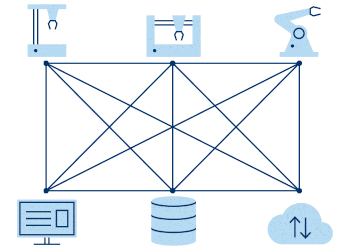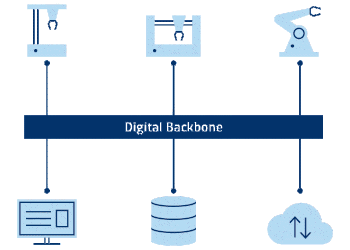To unlock the full potential of automation within a manufacturing environment, communication and interaction between all information systems must be enabled. A distributed communication layer must serve as the “digital backbone” of scalable manufacturing automation, particularly in environments with high equipment diversity along with a variety of distributed systems.
This type of communication structure provides flexibility for the expansion and integration of new applications, devices, services, communication methods, and protocols while also enabling data streaming capabilities along with the event-driven, and service-oriented architectures which are necessary for manufacturing automation and analytics. At its foundation, the digital backbone is built on message-oriented middleware (MOM) using event-driven architecture (EDA) patterns. MOM enables publish/subscribe communication that decouples producers (MES, ERP, tools, IIoT devices) from consumers (SPC/APC, analytics, AI, AMHS, historians), providing resilience, scalability, and flexibility for future growth.
Once an enterprise resource planning (ERP) system and manufacturing execution system (MES) are in place, the next logical step is the determination and implementation of technology to support the distributed communication layer which will facilitate the connection of existing IT systems and equipment, as well as any future manufacturing automation solutions, so that information can be exchanged seamlessly among the components.
What is a Digital Backbone?
A digital backbone is a carefully designed distributed communication layer that provides the infrastructure needed to support short and long-term scalability. When beginning a digital transformation journey, a short-sighted perspective might be to develop some sort of peer-to-peer integration between each new application and all of the already installed applications with which it needs to be integrated. This rapidly becomes unmanageable as each time a new application is deployed, all of the old applications need to be upgraded as well to integrate with the new one.

Instead of direct integration, an event-driven architecture (EDA) can be adopted by applications to expose services that address specific business needs. These can be general purpose, or as specific as needed. The applications that use the services don’t need to know anything about the inner workings of the service. All that is needed is that the server and the client applications agree on the interface definitions of the services. The distributed communication layer provides the means by which the servers and the clients communicate with each other.
The distributed communication layer (MOM + EDA) provides the mechanism for servers and clients—or producers and consumers—to exchange information reliably and consistently.
Benefits
Servers can be upgraded and new services added without requiring any changes to the clients
By carefully designing stateless servers, any client at any time can make a service request over the communication layer and always obtain a consistent response
Server instances can be added as needed, to provide additional load capacity, or to provide redundancy for more robustness
Legacy equipment without native communication capabilities can still be integrated via adapters or gateways

Digital Backbone Capabilities
As previously stated, the digital backbone is a carefully designed distributed communication layer that provides the infrastructure needed to support short and long-term scalability. The distributed communication layer enables many possibilities for communication as one or more systems' or equipment’s output necessarily becomes other systems' and/or equipment’s input.
The communication layer will provide a reliable and scalable foundation for other digital transformation strategies, such as:
Smart WIP Management
Consider a sales order that is received via the ERP and sent to the MES as a production order to be executed. The MES is then responsible for ensuring the execution of the appropriate processes and process steps while collecting, storing, and making data available regarding the product’s manufacturing process. To efficiently execute those tasks, information regarding the state of equipment required for processing is just one crucial element that can be delivered via the distributed communication layer. When equipment communication is enabled and connected to the distributed communication layer, the MES can receive information about:
- which equipment is available for processing material (and not processing any material at this time)
- which equipment is currently processing material;
- which equipment is under engineering control for tests, experiments, or any other activity
- which equipment is scheduled for a preventive maintenance (PM) procedure and, as a result of the procedure, cannot (or may not be permitted to) process material
- which equipment is unable to process material due to some type of unscheduled and/or unanticipated event
- and which equipment is unable to process material because of the effects of an external event, such as a facility shutdown or site-wide power failure
In an event-driven architecture, this information can efficiently be used to automate WIP management strategies. Solutions such as event-driven dispatching become pivotal, ensuring that equipment operators have instant access to vital information, allowing for the right material to be processed on the correct equipment at all times.
Live Reporting
Most modern factories still rely on periodic reports which provide a snapshot of the state of production over a previous period of time. While these reports do provide valuable information regarding KPIs, they only become available after the time has passed when a beneficial change could have been implemented. Enabling communication within an event-driven architecture between IT systems and equipment via a distributed communication layer allows for the immediate collection and analysis of data, providing for real-time reports on performance metrics like overall equipment effectiveness (OEE), equipment utilization and capacity, lot cycle times, throughput, yield, and WIP status. Real-time data also enables:
- drill-down capabilities for isolating and viewing information about single events
- root-cause analytics
- dynamic bottleneck detection
- and, for semiconductor manufacturers, automatic detection and classification of defects like scratches, rings, spots and clouds on wafers
With a digital backbone, real-time event streams replace lagging reports. One contextualized, high-velocity event stream can simultaneously power dashboards, SPC/APC systems, scheduling, and AI/ML models—without the need to re-integrate data for each new consumer.
Automated Equipment Setup
When setting up equipment to process material, operators have to know the exact product they are building, along with any special equipment recipes and parameters that are needed. In a dynamic, high-mix manufacturing environment, manually managing equipment setup can be difficult for operators. They should have access to some system that helps to manage all of this equipment setup information. And, ideally, this system, embedded within an event-driven architecture, can be integrated with the equipment through the distributed communication layer to fully automate the setup process, saving time, and reducing the possibility of errors.
Automated equipment setup is the foundation of advanced process control (APC) capabilities, such as fault detection and classification (FDC) and adaptive process control (run-to-run). With a digital backbone in place, a factory will have the infrastructure necessary to integrate equipment with the systems needed for APC capabilities.
Smart Communication for Manufacturing IT
There are countless scenarios in manufacturing environments where communication and data volume grow drastically along with a need for the integration of new applications, sensors, software components to optimize production. A thoughtfully designed and implemented digital backbone, based on an event-driven architecture, will provide the adaptable framework necessary to support this complexity over the long-term and accommodate communication among the many systems, devices, equipment and sensors to exchange the necessary data.
SYSTEMA’s Perspective
For more than 30 years, SYSTEMA has helped manufacturers design and implement digital backbones that unlock the scalability of smart factories. Our experience shows that MOM and EDA patterns are essential to avoiding point-to-point integration pitfalls and ensuring long-term adaptability. By combining these architectures with domain-specific expertise, SYSTEMA enables manufacturers to establish a resilient communication layer—one that not only supports today’s operations but also accelerates the adoption of future technologies.
